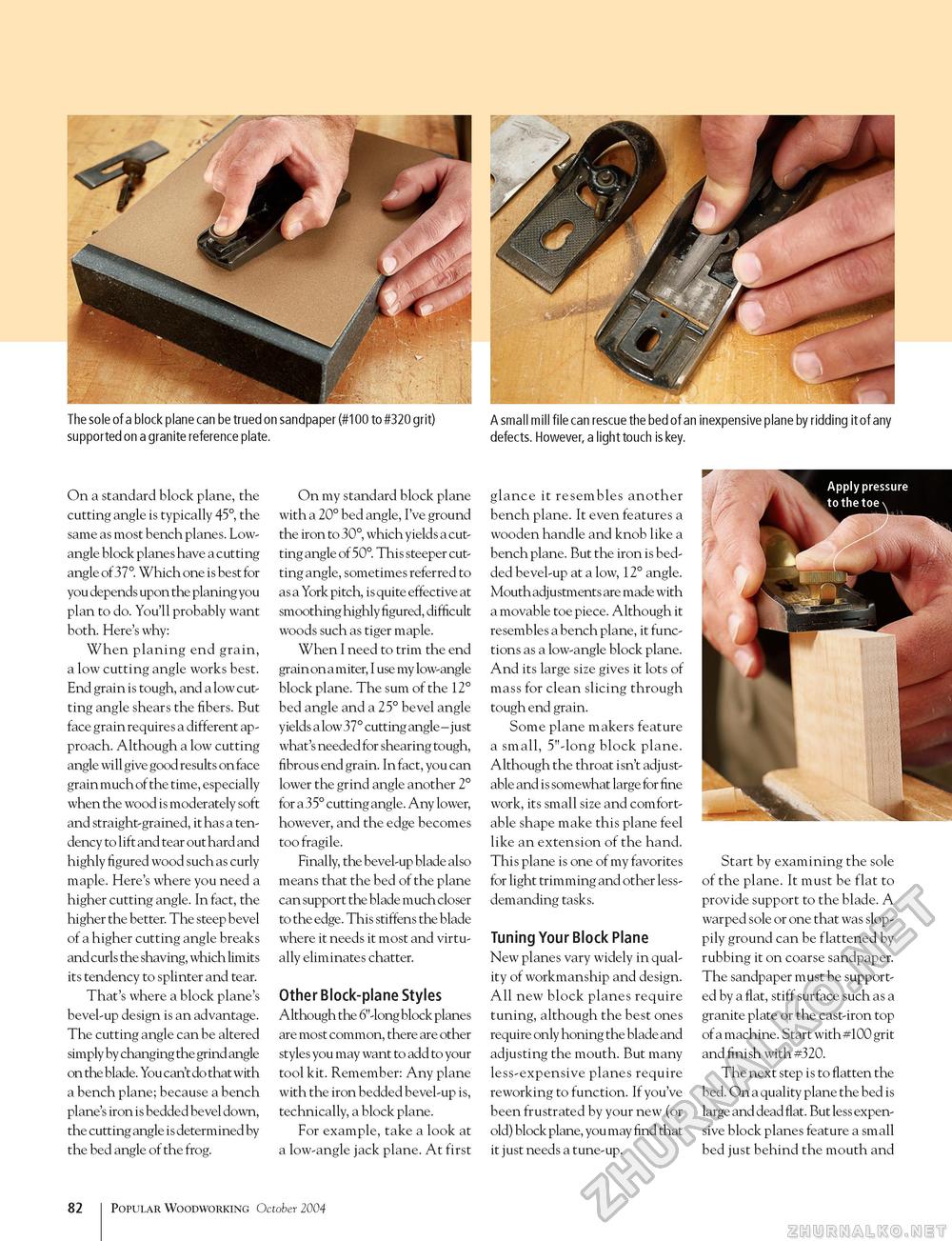Popular Woodworking 2004-10 № 143, страница 85
The sole of a block plane can be trued on sandpaper (#100 to #320 grit) supported on a granite reference plate. A small mill file can rescue the bed of an inexpensive plane by ridding it of any defects. However, a light touch is key. On a standard block plane, the cutting angle is typically 45°, the same as most bench planes. Low-angle block plane s have a cutting angle of 37°. Which one is be st for you depends upon the planing you plan to do. You'll probably want both. Here's why: When planing end grain, a low cutting angle works best. End grain is tough, and a low cutting angle shears the fibers. But face grain requires a different approach. Although a low cutting angle will give good results on face grain much of the time, especially when the wood is moderately soft and straight-grained, it has a tendency to lift and tear out hard and highly figured wood such as curly maple. Here's where you need a higher cutting angle. In fact, the higher the better. The steep bevel of a higher cutting angle breaks and curls the shaving, which limits its tendency to splinter and tear. That's where a block plane's bevel-up design is an advantage. The cutting angle can be altered simply by changing the grind angle on the blade. You can't do that with a bench plane; because a bench plane's iron is bedded bevel down, the cutting angle is determined by the bed angle of the frog. On my standard block plane with a 20° bed angle, I've ground the iron to 30°, which yields a cutting angle of 50°. This steeper cutting angle, sometimes referred to as a York pitch, is quite effective at smoothing highly figured, difficult woods such as tiger maple. When I need to trim the end grain on a miter, I use my low-angle block plane. The sum of the 12° bed angle and a 25° bevel angle yields a low 37° cutting angle - just what's needed for shearing tough, fibrous end grain. In fact, you can lower the grind angle another 2° for a 35° cutting angle. Any lower, however, and the edge becomes too fragile. Finally, the bevel-up blade also means that the bed of the plane can support the blade much closer to the edge. This stiffens the blade where it needs it most and virtually eliminates chatter. Other Block-plane Styles Although the 6"-long block planes are most common, there are other styles you may want to add to your tool kit. Remember: Any plane with the iron bedded bevel-up is, technically, a block plane. For example, take a look at a low-angle jack plane. At first glance it resembles another bench plane. It even features a wooden handle and knob like a bench plane. But the iron is bedded bevel-up at a low, 12° angle. Mouth adjustments are made with a movable toe piece. Although it resembles a bench plane, it functions as a low-angle block plane. And its large size gives it lots of mass for clean slicing through tough end grain. Some plane makers feature a small, 5"-long block plane. Although the throat isn't adjustable and is somewhat large for fine work, its small size and comfortable shape make this plane feel like an extension of the hand. This plane is one of my favorites for light trimming and other less-demanding tasks. Tuning Your Block Plane New planes vary widely in quality of workmanship and design. All new block planes require tuning, although the best ones require only honing the blade and adjusting the mouth. But many less-expensive planes require reworking to function. If you've been frustrated by your new (or old) block plane, you may find that it just needs a tune-up. Start by examining the sole of the plane. It must be flat to provide support to the blade. A warped sole or one that was sloppily ground can be flattened by rubbing it on coarse sandpaper. The sandpaper must be supported by a flat, stiff surface such as a granite plate or the cast-iron top of a machine. Start with #100 grit and finish with #320. The next step is to flatten the bed. On a quality plane the bed is large and dead flat. But less expensive block planes feature a small bed just behind the mouth and 82 Popular Woodworking October 2004 |








